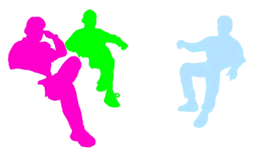ANITA FRICEK
Central to the work of Anita Fricek (*1967) is a specific part of contemporary Austrian history. The title of the series Unser Heim does not refer to so much to the family home, but rather to a social pedagogic institution in 1970s Austria, that constituted of a mix of socialist belief in progress, bourgeois conservatism and Catholic clerical fundamentalism. According to the pedagogical standards of the time, public children’s homes and private boarding schools were modelled on tight principles of order and discipline, to encumber natural socialisation processes and discourage individualism and independence. Apart from the homes and boarding schools, the artist also analyses the activities and holiday camps of various youth organisations and groups with a similar hierarchical structure.
Public and private documentation form the visual basis that Fricek converts into the medium of painting, which is here seen as a substitute for note taking, so as to allow a visualisation and analysis of the institutional and ideological power structures on a formal aesthetic level. The work Tagesraum – die Mädchen tanzen originates from a scene from the TV film ‘Bambule – Fürsorge – Sorge für Wen?’ by Ulrike Meinhof and Eberhard Itzenpiltz from 1970. Text fragments and the titles are embroidered onto the canvases. The painting Kinderübernahmestelle (KÜST) der Stadt Wien consists almost entirely of big square-edged letters. The institution appears as a threatening, seemingly hermetic building, an impression that is enforced by the dark range of colours in the painting. But it is not only the institution that is symbolised in Fricek’s paintings. In one, she shows a nun as a person representing superiority, alluding to the fact that most of the children’s homes and educational institutions were subordinated to the church. The Austrian state is symbolised by the Austrian flag that was originally seen as a sign of national wealth. However, in Fricek’s paintings, it symbolises the government’s intervention into the education of children.
Apart from the figurative reproduction of the original, geometrical forms also determine the composition of the works. The circle motif describes a space of delimitation from the institution and shows a movement, which optically ‘stands out’ from the canvas. In relation to this theme it can be seen as a form of resistance of the individual in relation to the institution. The circle-dance of the children in an Austrian SOS-Children’s Village is to be understood as such a diversion. Here the resistance is not to be understood through a binary opposition, but rather through the production of an ‘other’ reality defined by the individual.
By Nina Köller, translated by Eva May
"Jugend- und Schullandheim 1974" (2002)
(1,5 x 1 m, Öl auf Molino) Foto: Michael Nagl
|









